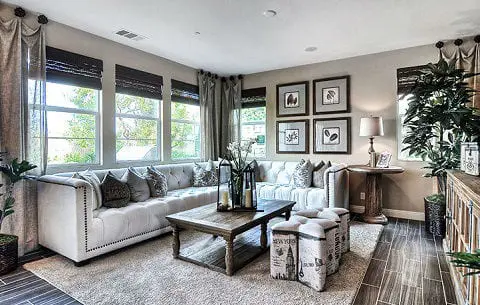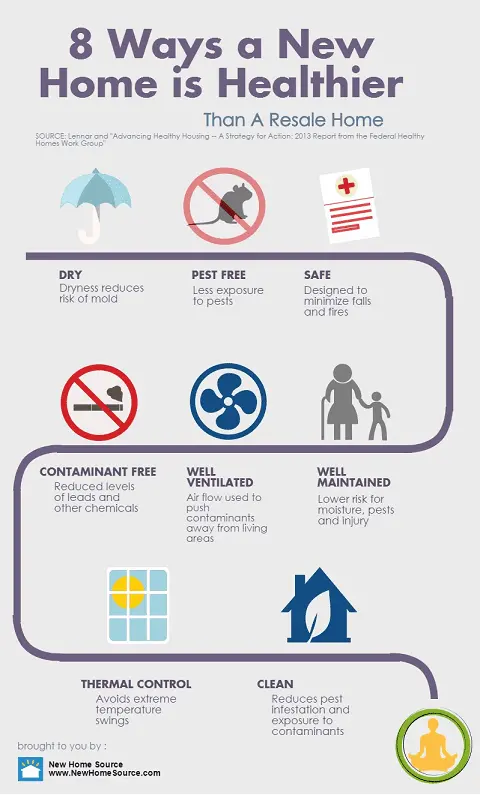
Whether your clients are perfectly healthy now and want to stay that way or they suffer from allergies or asthma and want to reduce their exposure to elements that cause outbreaks, a newly built home can offer benefits that are difficult to replicate in a resale.
“The average age of a resale in the (United States) is 50 years, so when you consider the changes in technology and advances in building techniques decade by decade, it’s not surprising that we know how to create a healthier home environment,” says Nikki Norman, a new home consultant with Lennar in Irvine, Calif. “Healthier products are being invented every day.”
While much of the focus of healthy homes rests on improving indoor air quality and eliminating chemicals from indoor products such as paints and carpets, a corollary component of a healthy home is safety.
“Newly built homes must meet today’s building codes, which are mostly related to the safety of residents and their guests,” says Brian Shanks, a senior purchasing professional with Beazer Homes in Atlanta, Ga. “Things like a smoke detector in every room, carbon monoxide detectors, (a safe way out) in case of a flood or a fire, tempered glass in some areas and even sprinkler systems in some states are now required. Not only do you not have those features in a resale, but you often don’t have them even in a remodeled home, depending on when the work was completed.”
Explaining Healthy Home Features to Buyers
While some aspects of today’s healthy homes can be technical and complicated to translate into layman’s terms, you can share information with potential new home buyers by delving into general categories of features, like the ones listed below:
Indoor Air Quality
“New homes are designed with the right ventilation systems that maintain energy efficiency yet also eliminate things like carbon monoxide and the chemicals generated by gas appliances,” says Shanks.
“In the 1970s, homes were built with a free flow of air in and out, so while bad air was exhausted from the home, hot or cold air from the outside came in,” shanks explains. ‘Then when people became concerned about energy efficiency, everyone learned to seal up the envelope with more insulation and tighter seals. Now we have corrected for that and have better indoor air quality.”
Norman says that all newly built homes use some type of ventilation system, although the actual products vary. She says Lennar uses a drywall product that breaks down adhesives and other chemicals to help clean the air – even after it’s been painted or covered by wallpaper.
“Your buyers may notice that there’s no ‘new paint smell’ in new homes even when they’re under construction because everyone is using low-VOC (volatile organic compound) paints,” says Norman.
In addition to low-VOC paint, builders are using different adhesives under tile flooring and carpets with fewer chemicals than in the past. Most builders no longer use fiberglass insulation, says Norman, and are instead switching to a plant-based, formaldehyde-free product. See this article from the American Lung Association to learn more about indoor air quality.

Safety Features
Even something as basic as the fuse box is typically safer in a new home, says Norman, because those boxes have a life span of 30 years and yet homeowners rarely replace them. “In a new home, you get a new fuse box with the newest in electrical technology,” Norman says.
Garage doors today have extra safety features such as an automatic stop sensor that can prevent someone being hurt by a closing door. New energy efficient windows not only reduce the loss of heat and air conditioning, but they also have safety features that differ from older windows.
“Smart home features keep homeowners safer because you can activate an alarm system, check that doors and windows are locked and allow authorized people into your home,” says Norman. Laminated insulating glass, for example, has polymer interlay that prevents shattering.
Moisture Reduction
“Older homes are more prone to issues with moisture,” says Shanks. “Today’s homes are built more tightly and with drainage to make sure water is drawn away from the house. In places that are prone to mold such as bathrooms, we don’t use paper-backed products anymore and instead use cement-based products underneath the tile.”
Norman says that moisture prevention to avoid mold issues starts with the foundation of a new home.
“Everything is wrapped from the foundation up to keep moisture from getting into the house, including sealers around the doors, the windows and the ceiling,” says Norman.
Psychological Factors
“There hasn’t been a lot of research about this, but personally I think that open floorplans and larger windows that let in a lot of natural light can be connected to healthier living,” says Shanks. “People feel better when they’re exposed to more daylight.”
While purchasing a healthy home may not be the number one goal for buyers, Shanks says a healthy home fits seamlessly with an energy-efficient home and a green home, all of which are priorities for many of today’s buyers.
“Younger buyers are often very interested in a healthy, clean and green way of living, so a newly built home can fit into that lifestyle,” says Norman. “They’re especially interested in this if they have a baby or plan to have children, but they’re also often concerned about the health of an older parent who may visit frequently or live with them. Every buyer wants the healthiest option for their money.”

